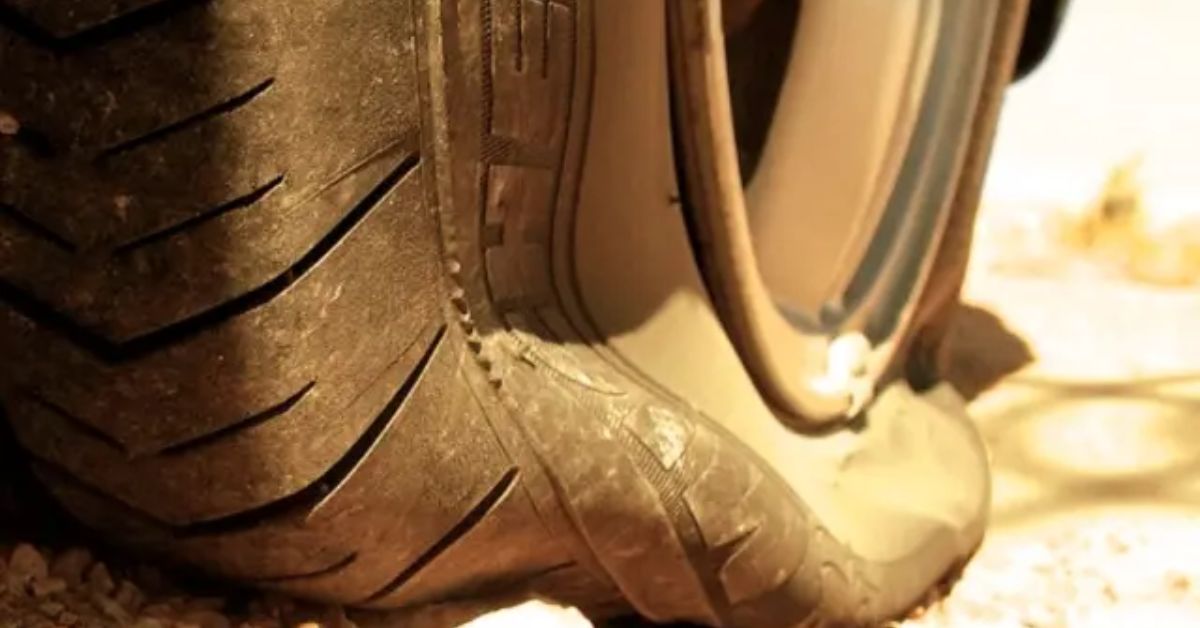A tire blowout is a sudden and often frightening experience that can happen to any driver. Knowing how to react can make the difference between safely getting off the road and facing a dangerous situation. Here’s a step-by-step guide on what to do if you experience a tire blowout while driving.
Staying safe during a blowout
If you have a tire blowoutt can be alarming, but staying calm is crucial. First, maintain a firm grip on the steering wheel to control the vehicle. Avoid slamming the brakes; instead, gently ease off the accelerator. Focus on steering straight and gradually slow down by lightly tapping the brakes if necessary.
Once the car is under control, signal and carefully move away from traffic to the side of the road. Turn on your hazard lights to alert other drivers. If you have passengers, ensure they remain inside the vehicle with seat belts fastened. Only exit the car if it’s safe, and position yourself away from the roadway while waiting for assistance. Regularly checking tire pressure and condition can help prevent blowouts, providing a safer driving experience for everyone.
What causes a tire blowout?
- Potholes and Road Hazards: Hitting a pothole or other road debris can cause immediate damage to the tire, leading to a blowout. Even if you don’t feel a significant impact, the tire could still be compromised.
- Overinflation or Underinflation: Incorrect tire pressure can lead to a blowout. Overinflation can cause excessive wear and make the tire more susceptible to punctures, while underinflation can cause the tire to flex more than it should, generating excessive heat and potentially leading to failure.
- Heat Buildup: Continuous driving at high speeds or with an overloaded vehicle can create excessive heat in the tires. This heat can weaken the tire structure, leading to a blowout.
- Tread Separation: Even in newer tires, poor manufacturing or defects can lead to tread separation. This occurs when the outer layer of the tire begins to detach from the inner layers, which can cause a blowout.
- Age of the Tire: Tires have a shelf life, and even if they appear to be in good condition, rubber can degrade over time due to exposure to environmental factors like UV light and ozone.
- Improper Installation: If the tire is not mounted correctly or balanced during installation, it might lead to uneven wear and increase the risk of blowouts.
- Foreign Objects: Nails, screws, or glass can penetrate the tire and cause slow leaks or sudden blowouts if they create a significant puncture.
- Driving Conditions: Extreme weather conditions, such as driving on hot pavement or in icy conditions, can also affect tire performance and increase the likelihood of a blowout.
How to prevent tires from blowing out
Preventing tire blowouts requires vigilance and regular maintenance. First, consistently check tire pressure using a reliable gauge, ensuring it aligns with the manufacturer’s recommendations typically found inside the driver’s door or the owner’s manual. Underinflated and overinflated tires significantly increase blowout risks. Regularly inspect your tires for signs of damage, such as cuts, punctures, or objects lodged in the tread. Ensuring that even tire wear is maintained through regular rotation, as your owner’s manual recommends, can also help prevent failures. Monitoring tread depth is crucial; tires with insufficient tread are more susceptible to blowouts. Avoid overloading your vehicle because excessive weight places additional strain on your tires. To avoid punctures, practice cautious driving, particularly on rough or debris-laden roads. Also, consider how your driving habits impact tire longevity; sudden stops, quick accelerations, and high-speed driving can accelerate wear. You significantly reduce the likelihood of experiencing a tire blowout by staying attentive to these preventive measures.
Does Insurance cover tire blowouts?
- Type of Coverage: Most auto insurance policies do not cover routine maintenance issues, which typically include tire wear and tear. However, if the blowout results from a sudden or accidental event—such as hitting an object on the road—collision coverage may apply.
- Deductibles: If you have collision coverage and decide to file a claim for a tire blowout caused by an accident, you must pay your deductible first. Depending on your deductible amount, it might not make financial sense to file a claim for just a tire replacement.
- Towing Services: Many insurance providers offer Coverage for towing services, which can be beneficial if your vehicle is immobilized due to a blowout.
- Liability Coverage: If a tire blowout leads to an accident that affects other vehicles or causes injuries, your liability coverage should cover damages to other parties, subject to the limits of your policy.
- Checking Your Policy: It’s crucial to review your specific insurance policy or consult with your insurance provider to understand the extent of your Coverage regarding tire blowouts.
In summary, whether Insurance covers tire blowouts can depend on your policy’s situation and terms, so it’s essential to be informed and prepared.
When managing the unexpected costs associated with tire blowouts, understanding your auto insurance policy is crucial. Generally, tire blowouts may or may not be covered by Insurance, depending on the circumstances and the specific policy you hold.
Types of Coverage to Consider
- Comprehensive Coverage: This type of Coverage typically protects against damage to your vehicle from incidents other than collisions. If a blowout is caused by an external factor, like hitting a pothole or running over debris, you can file a claim under your comprehensive Coverage.
- Collision Coverage: If a blowout leads to an accident—such as losing control and colliding with another vehicle or obstacles—collision coverage may kick in. This would help cover damages to your car and possibly other vehicles involved.
- Roadside Assistance: Many insurance policies offer roadside assistance that can provide help in the event of a tire blowout. This service usually covers towing, flat tire changing, and other emergency help.
Common Causes of Tire Blowout Accidents
Damaged Tires:
- Tires can become damaged from hitting potholes, curbs, or other road hazards. Signs of damage include bulges on the sidewall or tread or visible air leaks. If a tire is damaged, it should be repaired or replaced immediately to prevent blowouts.
- Underinflated Tires:
- Tires not inflated to the correct pressure can overheat and fail due to excessive stress. Regularly checking and maintaining the proper tire pressure, especially before long trips, is crucial to prevent blowouts.
- Overinflated Tires:
- Conversely, overinflation can also lead to blowouts. Overfilled tires can develop bulges and are more likely to burst under stress. It is essential to adhere to the recommended pressure limits specified on the tire sidewall.
- Overloading:
- Exceeding the vehicle’s weight limit can place excessive stress on the tires, increasing the risk of failure. It’s essential to check the vehicle’s weight capacity and avoid carrying too much weight.
- High Speeds:
- Driving at high speeds can significantly generate heat in the tires if they are underinflated or overloaded. This heat buildup can lead to tire failure and blowouts.
- Lack of Maintenance:
- Regular tire maintenance, including rotations, alignments, and inspections for wear, can help prevent blowouts. Neglecting these tasks can lead to uneven wear and an increased risk of tire failure.
Immediate Sensation and Reaction
- Sudden Noise: The first noticeable effect of a blowout is a loud noise, often described as a bang or popping sound. This noise can be startling and cause an instinctive reaction to swerve or break suddenly.
- Loss of Control: As the tire deflates rapidly, the vehicle can jerk to one side, making it difficult to steer. This loss of control can vary depending on which tire has blown; for example, a rear tire blowout may cause the back of the vehicle to sway or fishtail.
- Vibration and Pulling: Drivers often feel vibrations in the steering wheel and may notice the car pulling towards the side of the blown tire. It’s essential to remain calm and avoid overreacting during this phase.
What Does an Insurance Company Cover in a Tire Blowout Accident?
What Does an Insurance Company Cover in a Tire Blowout Accident? Understanding your insurance coverage is essential in the event of a blowout leading to a vehicle accident. Different types of insurance coverage can provide specific protections, and knowing these details can help you navigate potential claims or repairs. Here’s what to consider:
- Liability Coverage
- Bodily Injury: If a tire blowout causes an accident that results in injury to another person, your liability coverage will help cover medical costs and legal fees related to the injuries sustained by the other party. This applies if you are deemed at fault for the accident.
- Property Damage: If your blowout damages someone else’s property—such as another vehicle, a fence, or signage—your liability insurance can cover the repair or replacement costs.
- Collision Coverage
- If you have collision coverage, it can help pay for repairs to your vehicle after a blowout-related accident, regardless of fault. This is particularly useful if the accident resulted in significant damage or if the repairs exceed your deductible.
- Comprehensive Coverage
- While comprehensive Coverage typically protects against non-collision-related damages (like theft or natural disasters
Decreasing Your Risk of a Tire Blowout
- Regular Tire Maintenance: Make checking your tires a routine part of your car maintenance. Regularly inspect tire pressure, tread depth, and overall condition. Aim to check your tires every time you fill up your gas tank.
- Monitor Tire Pressure: Maintain your tires at the manufacturer’s recommended pressure levels. Under-inflated tires can generate excessive heat, increasing the risk of a blowout.
- Inspect for Damage: Look for any visible cracks, punctures, or bulges in the tire sidewalls. If you notice any damage, replace the tire as soon as possible.
- Be Mindful of Load Limits: Avoid overloading your vehicle beyond its capacity. If you tow or carry a heavy load, verify that your tires suit the added weight.
- Invest in Quality Tires: Consider using high-quality tires engineered for durability and safety, such as DriveGuard tires, which have cooling systems to help prevent blowouts.
- Stay Aware of Driving Conditions: Avoid driving on rough or poorly maintained roads, especially during hot weather when tires are more susceptible to damage.
- Keep a Roadside Emergency Kit: Equip your vehicle with an emergency kit that includes the necessary tools and supplies for changing a tire and a first aid kit.
- Professional Inspections: Schedule routine tire checkups with professionals at places like Firestone Complete Auto Care or Jiffy Lube. Their trained technicians can provide a thorough inspection and recommend replacements if necessary.
- Drive Cautiously: When driving, be attentive to road conditions and avoid sudden movements or hard braking that can place additional stress on your tires.
Conclusion
Experiencing a tire blowout can be stressful and dangerous, but knowing how to handle it can keep you safe. By staying calm, maintaining control of your vehicle, and following these steps, you can safely navigate a tire blowout and confidently get back on the road.






